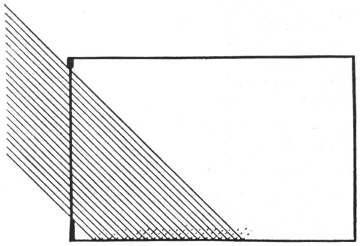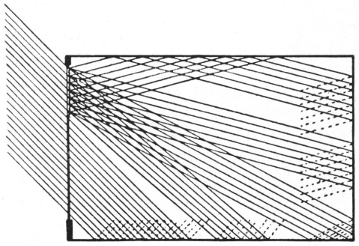|
Up: PPG |
Prism Glass · Page 137 Home > Prism Glass > United States > PPG > Page 137 |
Prism Glass 5 of 5 |
|
Up: PPG |
Prism Glass · Page 137 Home > Prism Glass > United States > PPG > Page 137 |
Prism Glass 5 of 5 |
 |
 |
|
| Fig. 1 | Fig. 2 |
|
SCIENTIFIC EXPLANATION OF THE PRISM WHEN transom sash are set with 3-Way Luxfer Pressed Prism Tiles,
the entire room is daylighted. Plain glass, on the other hand, permits the
lighting of only the part adjacent to the window. The effect of the prisms
is to bend up the light rays and project them to the farthest corners.
This use of the prism is made possible by a
fundamental law of optics. Light rays always travel in straight lines unless
reflected or refracted. According to one law of refraction, when light rays
pass obliquely from one medium into another of different density, they are
deflected, but upon passing through. and re-entering the original medium,
they are restored to their original direction, provided the planes of
approach and of exit are parallel.
When light rays pass through a sheet of plain
glass (figure 3), they are refracted toward the perpendicular to the surface
as they enter the glass, and away from the perpendicular as they leave it;
the angles of deflection being determined by the angles at which the rays
strike the two surfaces of the glass. But, as these surfaces are parallel,
the resultant direction at exit is the same as that of approach.
In figure 5 the rays approach the prism
surface at the same angle as the angle of approach in figure 3. but,
because the second surface of the prism is not parallel, but at an angle,
to the first, they still further change their direction as they leave,
different-angled prisms giving different resultant directions.
The commercial prism is a series of small
prisms moulded into the face of the tiles. These prisms, in the 3-Way
Luxfer Tiles, are of different angles, so as to bend the light in different
directions.
Figure 1 shows how light passes directly
through an ordinary pane and is reflected by the walls.
Figure 2 shows how light passing through a plain
glass window with a 3-Way Luxfer Transom above is bent up by refraction
in new directions, searches out and daylights every part of the room,
and is reflected from every wall. Figure 4 shows this in another way.
3-Way Luxfer Pressed Prism Tiles are made in
two types: Luxfer, or Flat Back, for average installations,
and 3-Way, or Lens Back, for locations where daylight must
be gathered from sides as well as from above.
Only experts should be consulted, in order
that prisms of proper angle be selected, as is essential.
|
 |
 |
 |
||
| Fig. 3 | Fig. 4 | Fig. 5 |